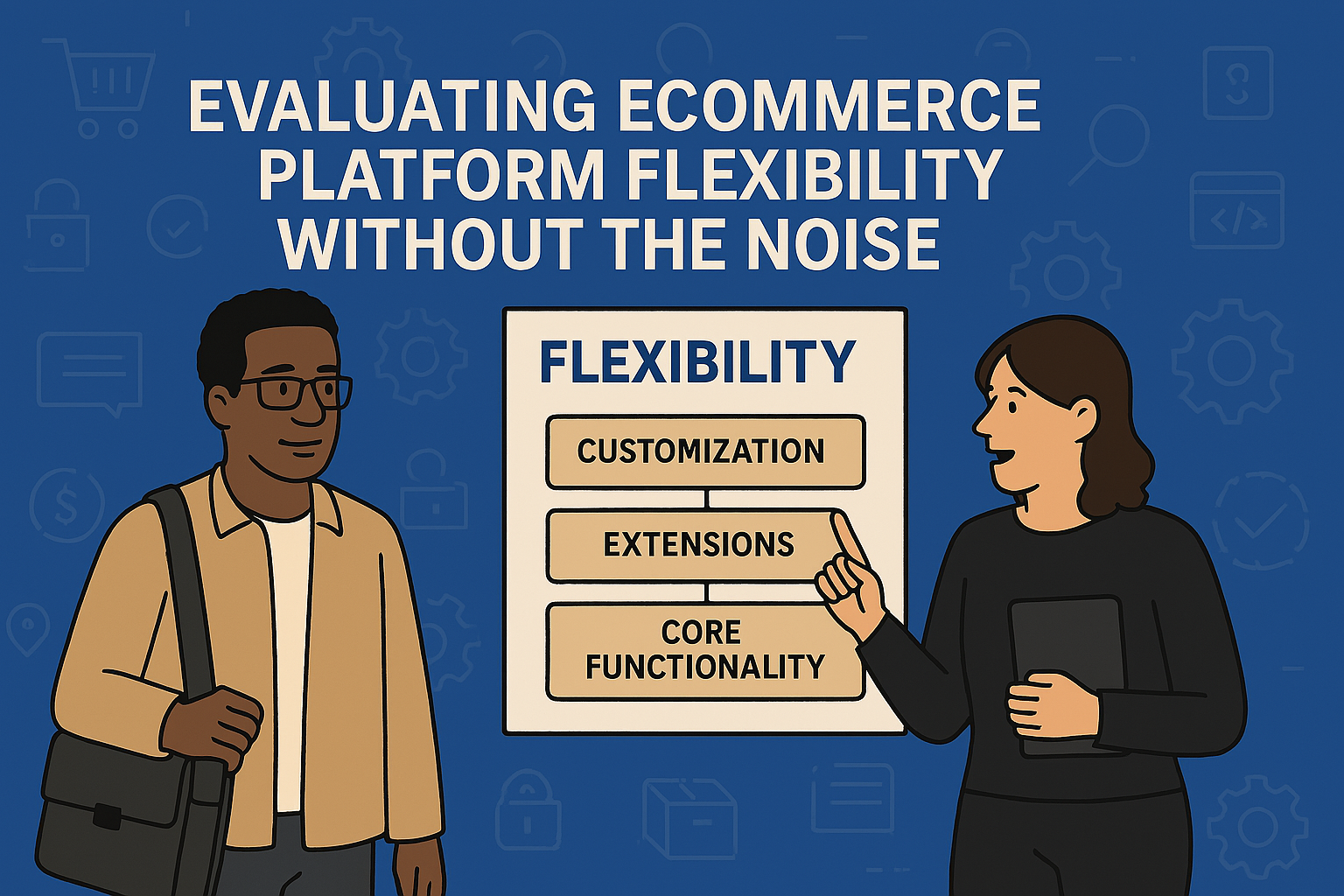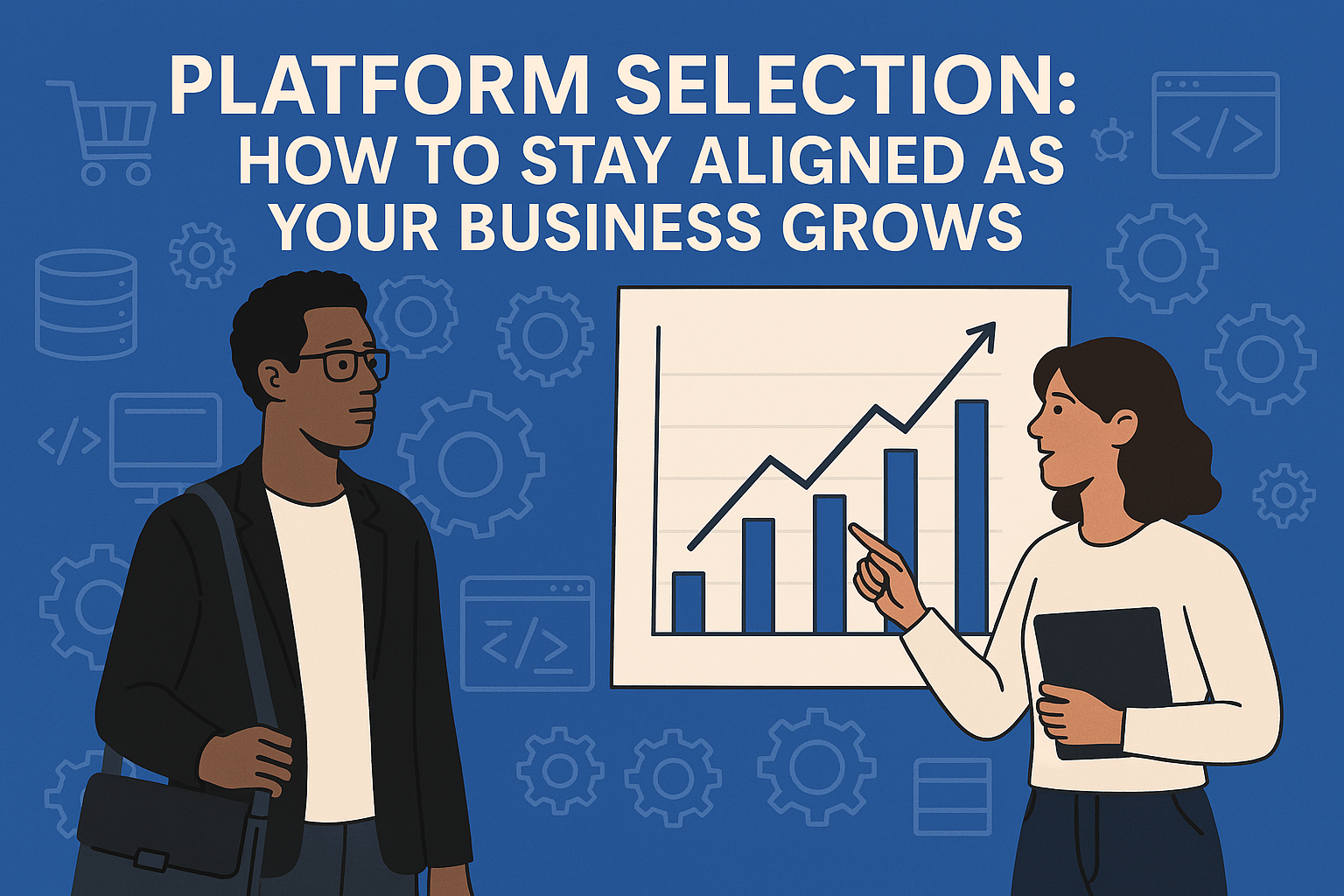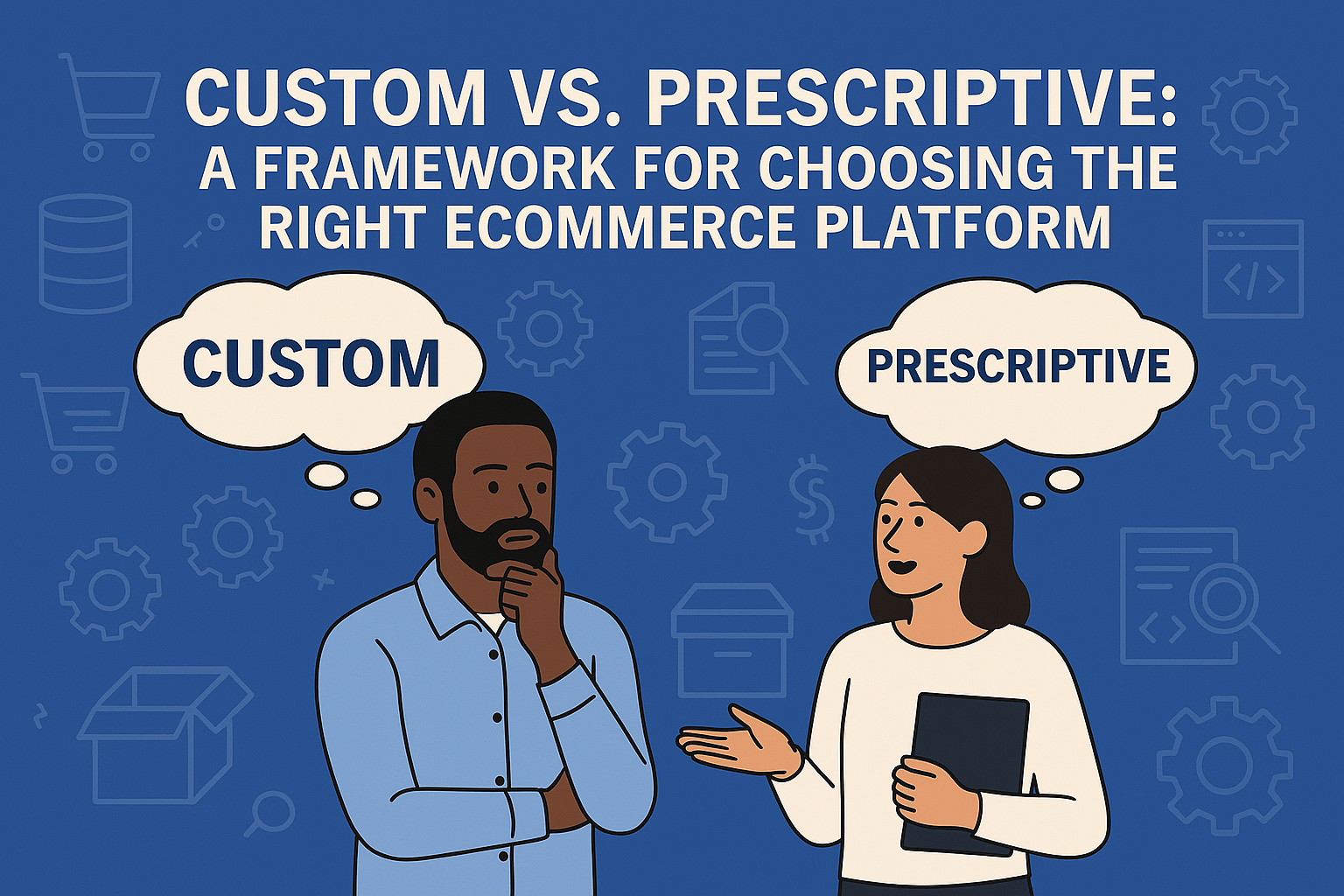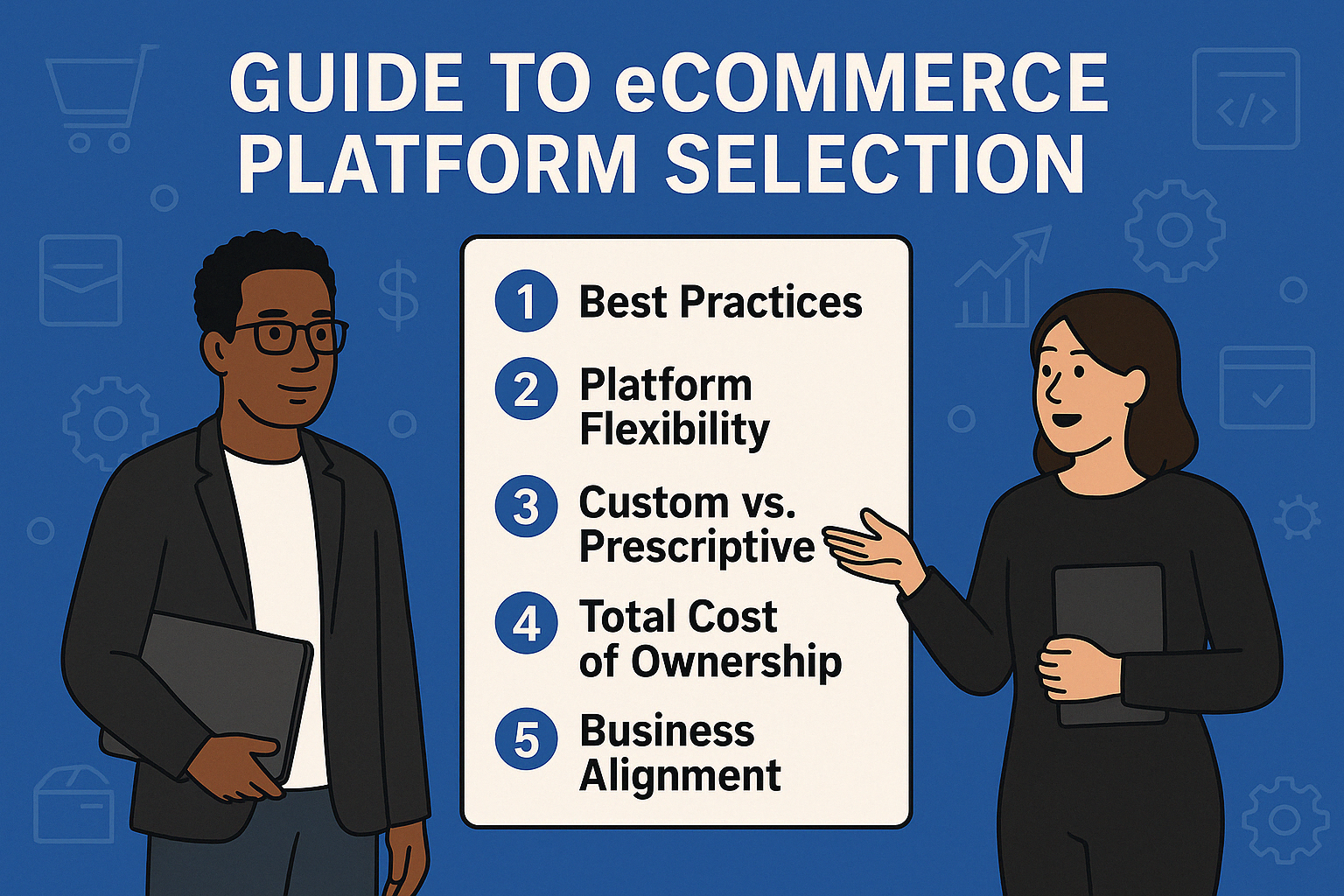Platform Selection: How to Stay Aligned as Your Business Grows
Following eCommerce platform selection, evaluate ongoing platform alignment, lock-in, and potential technical debt as your eCommerce business evolves.
4 min read
 Tim Bucciarelli
:
April 25, 2025
Tim Bucciarelli
:
April 25, 2025

When businesses evaluate eCommerce platforms, the process often starts with a feature checklist: Does it support subscriptions? Multi-warehouse fulfillment? Customer segmentation? At first glance, most leading platforms seem to check the same boxes.
But meaningful differences in platform flexibility often emerge in the layers beneath those checklists—first in the availability and quality of apps, modules, and integrations, and then in the platform’s ability to support fully customized functionality.
Think of it as three layers:
The right level of flexibility depends on your strategic intent. If your goal is to fit in—delivering a familiar, efficient eCommerce experience—then a prescriptive platform with a mature app ecosystem might be enough. If you’re aiming to stand out—with differentiated workflows, design, or customer experience—then custom Magento development becomes critical. But that approach requires more than vision. It requires the internal capacity or agency partnership to execute consistently and efficiently.
This article will help you look beyond surface-level comparisons to understand how platform flexibility really works. We’ll define what flexibility means in context, explore where it shows up, and provide a structure for evaluating how well a platform can support the way your business operates—and where it’s headed.
Flexibility is a word that shows up often in eCommerce platform marketing—but it rarely comes with a clear definition. In practical terms, platform flexibility is the degree to which a platform allows you to shape your site to meet your specific operational, customer, and growth needs—without introducing unnecessary complexity or cost.
Flexibility isn’t about having more features. It’s about how easily you can:
How easy is it to adjust settings, turn features on and off, or reconfigure workflows without writing code? Some platforms offer extensive configuration options out of the box, while others are more rigid—requiring workarounds or paid add-ons for even common changes.
What’s the quality and depth of the platform’s app/module ecosystem? Are there well-supported, well-documented tools to extend functionality without starting from scratch? Are third-party systems easy to connect? This is often where major platforms begin to diverge in real-world usability. If integration is a core concern, IronPlane’s integration services are designed to help streamline those connections.
When standard tools and extensions aren’t enough, how easily can you build what you need? Does the platform offer a clean API, composable architecture, or full code access? Or does it resist modification in favor of tight guardrails? Custom development may be the right path when deep control is required.
Understanding which of these layers matters most to your business is critical. Not every company needs deep customization. But if your business depends on processes or experiences that don’t fit the mold, a lack of flexibility will eventually become a constraint—or a source of ongoing workarounds and costs.
Flexibility means little in the abstract. To evaluate it meaningfully, businesses need to understand where flexibility shows up in their day-to-day operations—and where platform constraints can impact outcomes.
According to the Future Commerce “Honest Truth” report, 86% of merchants say the ability to customize is a crucial consideration when selecting a platform. Yet four out of five also say speed to market is the most important factor in realizing revenue growth1. This captures the central trade-off: prescriptive platforms help you launch faster but may limit how well you can adapt the platform as your business evolves.
Here are four areas where flexibility tends to matter most—and how to assess it objectively during platform evaluation:
The checkout experience directly affects conversion rates. Evaluate whether you can modify the checkout logic, UI, or payment options without relying entirely on custom code. If you're working with Magento, IronPlane's Magento support can assist in optimizing and customizing your checkout process.
Consider how well the platform supports your internal processes—order routing, fulfillment logic, inventory visibility, customer service workflows. Prescriptive platforms often push merchants toward default workflows that may not align with existing systems. eCommerce consulting can help tailor your platform to your business operations.
Most eCommerce businesses rely on ERPs, PIMs, CRMs, or marketing platforms. The ease (or difficulty) of integrating these systems is a key test of platform flexibility. Look for stable APIs, existing connectors, and a track record of successful integrations.
Can your non-technical teams manage content, promotions, and merchandising easily? Or will they need developer support for everyday tasks? This type of flexibility directly impacts long-term cost and agility and relates to your ability to optimize the customer experience.
As Future Commerce notes, the term “flexible” is used so frequently in vendor pitches that it has lost meaning. Many “flexible” platforms simply offer a set of themeable components over rigid back-end systems. The real test is whether flexibility extends into operational reality—not just branding.
Platform flexibility isn’t just a technical requirement—it’s a strategic lever. Your approach to flexibility should align with how you want your business to show up in the market: are you aiming to fit in or stand out?
If your goal is to offer a familiar, efficient eCommerce experience, then a prescriptive platform with a strong ecosystem may be the best fit. You’ll benefit from speed, predictability, and reduced maintenance overhead.
If you differentiate through workflow, product experience, or customer engagement, you’ll likely need deeper customization capabilities. But that requires technical leadership and discipline—to ensure the solution remains stable and maintainable.
Most businesses land somewhere in the middle. The key is to identify where flexibility delivers value—and where simplicity is a better option. Flexibility isn’t about saying “yes” to everything. It’s about supporting what makes your business work.
Most eCommerce platforms can support the same core functionality. The real difference lies in how each platform allows you to configure, extend, and customize that functionality as your business evolves.
Checklists can’t tell you that. Neither can the word “flexible” in a vendor’s pitch. What matters is whether the platform gives you the right level of control in the areas that matter to your business—without introducing complexity you don’t need.
Start by understanding your priorities: Are you trying to fit into the market with speed and simplicity, or stand out with custom experiences and differentiated workflows? Then evaluate flexibility across three layers—core capabilities, extension ecosystem, and customization potential—with those goals in mind.
Flexibility is valuable when it supports growth, differentiation, or operational efficiency. It's costly when it creates friction without benefit. Knowing the difference is what makes for a smart platform choice—and a sustainable digital strategy.
Read next: Understanding the True Cost of eCommerce Platform Support and Maintenance
1 Source: Future Commerce, “The Honest Truth: Unmasking the Software Selection Charade,” 2023

Following eCommerce platform selection, evaluate ongoing platform alignment, lock-in, and potential technical debt as your eCommerce business evolves.

eCommerce platform selection requires understanding your true needs. How do SaaS, PaaS, and Self-Hosted platforms align with growth, budget, and goals?

A five-part guide to eCommerce platform selection: platform flexibility, custom vs. prescriptive models, total cost of ownership, and long-term alignment.